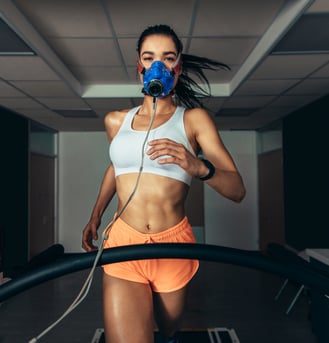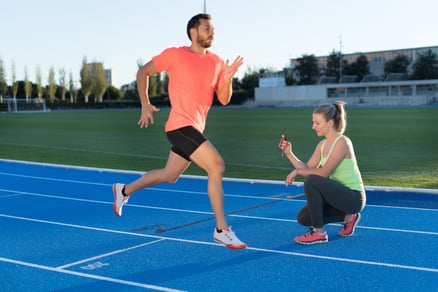 VO2 max testing, or graded exercise testing, is a treadmill run or cycle to volitional fatigue—or pretty much going until you must stop. The test will tell us how many liters of oxygen you are able to take in and use for cellular respiration.
VO2 max testing, or graded exercise testing, is a treadmill run or cycle to volitional fatigue—or pretty much going until you must stop. The test will tell us how many liters of oxygen you are able to take in and use for cellular respiration.
Physiologically, people use oxygen for a variety of things. The main purpose is for the oxygen to get into the cells’ mitochondria so that it can be used to generate adenosine triphosphate (ATP), which is the main energy source in the body. People use ATP to do pretty much everything: move our muscles, think, and even digest food. So the more oxygen you can take in and convert to energy, the longer and faster you can run due to this surplus of energy you are making at the cellular level.
What the Test Is Like
The test starts at a low speed and no incline on the treadmill. Then every so often the treadmill gets a little faster and a little higher. The increases are almost unnoticed and most start out walking. On the other hand, on the cycle, the resistance gets a little harder occasionally and the participant is expected to maintain the same rotations per minute (RPM). With both tests, the person is expected to go until they feel they must stop, when their workload is too great to maintain or their legs become too fatigued to continue.
What the Test Measures
While exercising, you will be hooked up to different devices to monitor your vitals such as a heart rate monitor and a ventilator of sorts. Some tests will also measure blood pressure and rate of perceived exertion. Trainers can use the information from these devices to generate a customized endurance program for you to push you to increase your VO2 max, and in turn, your overall endurance. VO2 max testing is a great way to know where you are currently at in your endurance training. It is comparable to doing repetition max testing on weights in strength training.
How the Results Can Shape Your Training
Trainers can utilize the data from a VO2 max test to make a program customized to your physiology. From a VO2 max test we can see what your heart rate maximum is exactly, and using these numbers we can get more accurate training zones for you. The ventilator gives a variety of useful data such as your aerobic threshold, or the point when you really start to breathe hard. This is the point where a person really starts to hate running, so knowing this point can help us stay below that more often, making the training more enjoyable while still receiving the benefits. Knowing different heart rate zones can help prevent overtraining and help push you to your fullest capacity, causing your body to adapt and consume more oxygen.
The measurements of blood pressure and perceived exertion are more common in a clinical setting to ensure normal responses to exercise, so they are not always necessary in healthy populations. The trainer can use rate of perceived exertion, however, to know how a person feels at certain running speeds. If someone feels that they are working very hard at a faster speed, the trainer may stay below that speed more often to make the runner more comfortable; and if a certain speed feels very easy, the trainer may ramp up the pace.
VO2 Max Testing at NIFS
Korr CardioCoach metabolic system VO2 max testing is offered here at the National Institute for Fitness and Sport. Connect with a trainer at the track desk if you have any interest or questions. VO2 max testing is a great way to gauge your endurance level going into marathon training, and a great way to pace yourself in a race by knowing where you are at physiologically at different workloads. Knowing your VO2 max as a runner is like how a powerlifter knows what the maximum amount of weight they can bench is. If you don’t have a benchmark going into a competition, you run the risk of over- or under-shooting and not performing as well. You don’t necessarily have to partake in a full VO2 max test if you are concerned about going to volitional fatigue. There are submaximal tests and estimation equations that can be utilized to get a rough estimate of your VO2 max. See a NIFS staff member with any questions you have pertaining to a VO2 max test or to schedule your test today.
This blog was written by Grant Lamkin, NIFS Health Fitness Specialist. To learn more about the NIFS bloggers, click here.


 In a world where people want results in an instant and take drastic measures to achieve those results as fast as possible, developing strength, power and athleticism in a long-term aspect is often overlooked. For any fitness-related result or outcome, improvements take time. Fat loss, overall strength and/or power in any particular lift, speed, and agility are all seeds that needed to be watered for a while before noticeable and permanent changes are evident.
In a world where people want results in an instant and take drastic measures to achieve those results as fast as possible, developing strength, power and athleticism in a long-term aspect is often overlooked. For any fitness-related result or outcome, improvements take time. Fat loss, overall strength and/or power in any particular lift, speed, and agility are all seeds that needed to be watered for a while before noticeable and permanent changes are evident.